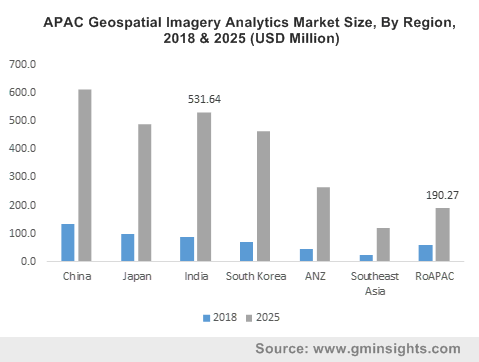Agricultural applications to drive geospatial imagery analytics market share
Publisher : Fractovia | Published Date : 2019-07-17Request Sample
Geospatial imagery analytics market is poised to witness remarkable momentum primarily due to the widespread acceptance of GPS technologies, mapping services, and remote sensing in various business domains. Today, advanced and innovative imaging solutions provide enormous potential to improve efficiency of large scale operations like farming, transportation, mining and telecommunications. Geospatial analysis is increasingly being used to help farmers cut costs and increase yield, which in turn presents a promising revenue source for global geospatial imagery analytics industry.
APAC Geospatial Imagery Analytics Market Size, By Region, 2018 & 2025 (USD Million)

Everyday farmers face a number of challenges and uncertainties such as unpredictable weather, need for producing more food with less environmental footprint, land degradation, and pest insurgence. Fulfilling these challenges with evolving demands and faltering crop productivity is compelling the adoption of modern technologies in agricultural field, opening doors for geospatial imagery analytics. According to the Food and Agriculture Organization, by 2025 the world population is anticipated to reach 8.5 billion, which signifies a massive requirement for food grains. This dramatic surge in general population entails significant enhancement of farming operations.
Geospatial imaging has proved to be an efficient and successful tool for farm production planning which can result in higher productivity and improved efficiencies in agriculture activities. Geospatial technologies including GIS, GPS, remote sensing, utility terrain vehicle and cloud-based technology allow farmers to detect patterns and trends in agricultural activities that are hard to notice via traditional methods. It ultimately helps to lower costs, in addition to detecting risks like erosion which protects the yield of farmers. Increasing adopting of such technologies in farming will augment geospatial imagery analytics market size over the forecast timeline.
Government authorities and local agencies in emerging economies are extensively focusing on remote sensing data, in order to take vital decisions regarding the future policies to implement successfully. This includes providing farmers useful information about their crop and soil health condition, while taking measures to tackle unpredictable issues. For instance, to aid farmers in large numbers, government of India had introduced a scheme for mapping of soil done using GIS, with an aim to help farmers take crucial and strong decisions. Execution of such projects will certainly provide a boost to farming activities and propel geospatial imagery analytics industry trends over the forecast period.
Countries like China, Japan, India, and Southeast Asia are quickly embracing novel technologies like cloud computing and internet of things (IoT) in public and private domains. These technologies are comprehensively equipped for accumulating data from leading tools like satellite images, soil sensors, and weather stations, which, in turn, enable farmers to manage their crops suitably. Shrinking costs of cloud-based implementations will allow governments to install required systems to complement new geospatial technologies. It is estimated that geospatial imagery analytics market share from the agricultural sector will record a 25% CAGR over the projected timeframe.
European Space Imaging had recently signed an agreement with Maxar Technologies to provide EarthWatch and SecureWatch to customers in North Africa, Europe, and CIS countries. This solution provides customers online and offline access to worldwide content layers via a single interface. Through these subscription-based services, the customers get instant access to Maxar’s WorldView satellite imagery and geospatial data. Fruitful partnerships, acquisitions and productive R&D efforts by the leading players is expected to advance spatial imaging capabilities in the near future, accelerating geospatial imagery analytics industry outlook.
Owing to the enormous potential of digital transformation trends in agriculture, geospatial imagery services have established a strong foothold worldwide. KeyW Holding Corporation, Hexagon AB, Maxar Technologies Inc., Satellite Imaging Corporation, General Electric Company, TomTom International B.V., PrecisionHawk, and RMSI Private Limited are some of the prominent players in the industry. Global Market Insights, Inc., predicts that global geospatial imagery analytics market will generate annual revenues of over USD 8 billion by 2025.